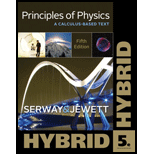
Concept explainers
(a)
The number of loops in the pattern
(a)
Answer to Problem 28P
The pattern exhibits a total of
Explanation of Solution
Write the expression for the wave function of a standing wave.
Here,
Write the given equation for the wave function of standing waves
Compare equation (I) and equation (II) to find the value of wave number.
Write the equation for the wave number.
Here,
Compare equation (I) and equation (II) to find the value of the angular frequency
Write the expression for the angular frequency.
Here,
Conclusion:
The distance between two adjacent nodes is half the wavelength of the standing wave. Write the equation for the distance between two adjacent nodes.
Substitute
The number of loops is the ration between the length of the wire and the distance between the two adjacent nodes. Write the equation for the number of loops.
Here,
Therefore, the pattern exhibits a total of
(b)
The fundamental frequency of vibration
(b)
Answer to Problem 28P
The fundamental frequency of vibration of the wire is
Explanation of Solution
Refer SUB-PART (a)
Conclusion:
Write the equation for the speed of the wave.
Here,
Substitute
The simplest standing wave has the distance of the wire as the distance between the adjacent nodes as they have only two nodes, one at each end.
Also, the distance between the nodes at this case is half the wavelength of the simplest standing wave.
Here,
Write the expression for the frequency of the simplest standing wave in this case.
Substitute
(c)
The number of loops in the new pattern
(c)
Answer to Problem 28P
The new pattern has
Explanation of Solution
Write the equation for the velocity in terms of the tension on the string.
Here,
Write the equation for the tension on the string when the tension is increased by
Here,
Write the new equation for the speed of the wave when the tension is increased.
Conclusion:
Substitute equation (XI) in equation (XII).
Substitute
Write the equation for the wavelength of the wave when the tension on the string is increased.
Here,
The distance between the nodes at this case is half the wavelength of the standing wave.
Substitute
Therefore, the distance between two adjacent nodes when the tension is increased is
Want to see more full solutions like this?
Chapter 14 Solutions
Principles of Physics
- Two sinusoidal waves are moving through a medium in the same direction, both having amplitudes of 3.00 cm, a wavelength of 5.20 m, and a period of 6.52 s, but one has a phase shift of an angle . What is the phase shift if the resultant wave has an amplitude of 5.00 cm? [Hint: Use the trig identity sinu+sinv=2sin(u+v2)cos(uv2)arrow_forwardA string with a mass of 0.30 kg has a length of 4.00 m. If the tension in the string is 50.00 N, and a sinusoidal wave with an amplitude of 2.00 cm is induced on the string, what must the frequency be for an average power of 100.00 W?arrow_forwardA copper wire has a radius of 200 µ m and a length of 5.0 m. The wire is placed under a tension of 3000 N and the wire stretches by a small amount. The wire is plucked and a pulse travels down the wire. What is the propagation speed of the pulse? (Assume the temperature does not change: (=8.96gcm3,Y=1.11011Nm) .)arrow_forward
- A steel wire of length 30.0 m and a copper wire of length 20.0 m, both with 1.00-mm diameters, are connected end to end and stretched to a tension of 150 N. During what time interval will a transverse wave travel the entire length of the two wires?arrow_forwardThe overall length of a piccolo is 32.0 cm. The resonating air column is open at both ends. (a) Find the frequency of the lowest note a piccolo can sound. (b) Opening holes in the side of a piccolo effectively shortens the length of the resonant column. Assume the highest note a piccolo can sound is 4 000 Hz. Find the distance between adjacent anti-nodes for this mode of vibration.arrow_forwardA sound wave in air has a pressure amplitude equal to 4.00 103 Pa. Calculate the displacement amplitude of the wave at a frequency of 10.0 kHz.arrow_forward
- The frequency of vibrations of a vibrating violin string is given by f = 1/2Lsqrt(T/P) where L is the length of the string, T is its tension, and ρ is its linear density.† (a) Find the rate of change of the frequency with respect to the following. (i) the length (when T and ρ are constant) (ii) the tension (when L and P are constant) (iii) the linear density (when L and T are constant)arrow_forwardA block with a speaker bolted to it is connected to a spring having the spring constant k = 40 N/m. The total mass of the block and speaker is 8.00 kg, and the amplitude of this unit's motion is 0.500 m. If the speaker emits sound waves of frequency 440 Hz, determine the highest and lowest frequencies heard by the person to the right of the speaker? Find the length of tube opened on one end such that its third harmonic would match the highest frequency heard by the observer.arrow_forwardA sound wave with a frequency of 9800 Hz travels along a copper pipe. If thewavelength is 0.370 m and the density of copper is 8.9 x 10^3 kg/m^3, what is the elastic modulus of copper?arrow_forward
 Physics for Scientists and Engineers, Technology ...PhysicsISBN:9781305116399Author:Raymond A. Serway, John W. JewettPublisher:Cengage Learning
Physics for Scientists and Engineers, Technology ...PhysicsISBN:9781305116399Author:Raymond A. Serway, John W. JewettPublisher:Cengage Learning Principles of Physics: A Calculus-Based TextPhysicsISBN:9781133104261Author:Raymond A. Serway, John W. JewettPublisher:Cengage Learning
Principles of Physics: A Calculus-Based TextPhysicsISBN:9781133104261Author:Raymond A. Serway, John W. JewettPublisher:Cengage Learning Physics for Scientists and Engineers: Foundations...PhysicsISBN:9781133939146Author:Katz, Debora M.Publisher:Cengage Learning
Physics for Scientists and Engineers: Foundations...PhysicsISBN:9781133939146Author:Katz, Debora M.Publisher:Cengage Learning University Physics Volume 1PhysicsISBN:9781938168277Author:William Moebs, Samuel J. Ling, Jeff SannyPublisher:OpenStax - Rice University
University Physics Volume 1PhysicsISBN:9781938168277Author:William Moebs, Samuel J. Ling, Jeff SannyPublisher:OpenStax - Rice University



